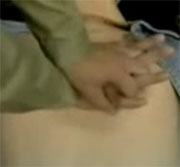
WEDNESDAY, March 17 (HealthDay News) — The availability of public automated external defibrillators (AEDs) increases the odds of surviving a heart attack with little neurological consequences, suggests new research.
In Japan, where AEDs are available nationwide, a study found that about 14 percent of people who had bystander-witnessed cardiac arrest from an irregular heart rhythm survived with a good neurological outcome. By contrast, 31.6 percent of those given a shock from a public-access AED survived with minimal neurological consequences.
In addition, the study found that bystander-initiated cardiopulmonary resuscitation (CPR) was also associated with better outcomes.
“This study clearly showed that the number of patients who received shocks from public-access AEDs and survived from out-of-hospital cardiac arrest increased as the number of public-access AEDs increased,” said one of the study’s authors, Dr. Taku Iwami, an assistant professor at Kyoto University Health Service in Japan. “This is the first study to show that the nationwide dissemination of public-access AEDs actually increases the rate of survival after cardiac arrests and this result reinforces the importance of the public-access defibrillation concept.”
The study also shows the effectiveness of bystander-initiated CPR — either chest compression only or compression plus ventilation — for cardiac arrests, said Iwami. “If you witness a sudden collapse, perform at least chest compressions until medical help and an AED arrives,” he added.
The availability of AEDs has been increasing, particularly in crowded areas such as health clubs or airports. In Japan, where the current study was conducted, the number of public AEDs went from 9,906 in 2005 to 88,265 at the end of 2007.
The researchers sifted through data on more than 312,000 out-of-hospital cardiac arrests. They found that 12,631 of these people had cardiac arrest with ventricular fibrillation, a type of irregular heart rhythm that is possible to correct with defibrillation, and their cardiac arrest was witnessed by bystanders.
Lay people used public-access AEDs in 3.7 percent of these cases during the three-year study period. As the availability of AEDs increased, so did the use of public-access AEDs, from 1.2 percent at the start of the study to 6.2 percent at the end.
The average time before someone with cardiac arrest received a defibrillator shock decreased from 3.7 to 2.2 minutes. And, the average number of people who survived with minimal neurological impairment increased from 2.4 to 8.9 people per 10 million.
Results of the study are published in the March 18 issue of the New England Journal of Medicine.
“This critically important research is the first to demonstrate that on a national level, increasing AEDs can improve survival,” said Dr. Anthony Aizer, an assistant professor in the department of medicine at NYU Langone Medical Center in New York City. “It is likely to change efforts in many industrialized countries to provide greater access to AEDs. However, it must also be taken in the context of other research. AEDs improve survival in airports and casinos, but have not proven to be beneficial in homes.”
While the study found that both AED use and CPR could be lifesaving, many people hesitated to use either technique. Just 7 percent of bystanders were willing to use an AED and just 50 percent initiated CPR.
“It’s terrifying to see someone dying in front of you, and people may panic or be scared to use a defibrillator or try CPR,” explained Dr. Dana Peres Edelson, an assistant professor and director of clinical research at the Emergency Resuscitation Center at the University of Chicago Medical Center. “But, AEDs are made so that someone who’s never seen one at all can do it. They’re really easy and user-friendly. And, really, anyone can do CPR; the key is to be willing to do it,” she said.
“To do CPR, first call for help, then put your hands together right on the sternum and push hard and push fast and don’t stop until help arrives. Chest compressions are essential,” she said.
More information
Learn more about public defibrillators from the American Heart Association.

